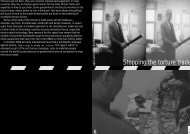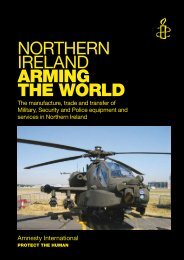CROWD CONTROL TECHNOLOGIES - Omega Research Foundation
CROWD CONTROL TECHNOLOGIES - Omega Research Foundation
CROWD CONTROL TECHNOLOGIES - Omega Research Foundation
You also want an ePaper? Increase the reach of your titles
YUMPU automatically turns print PDFs into web optimized ePapers that Google loves.
1. INTRODUCTION<br />
SECTION B: ARGUMENTS AND EVIDENCE<br />
This present study grew out of a 1997 STOA report, 'An Appraisal of the Technologies of Political<br />
Control' of which crowd control weapons were a part, and takes that work further. 6 Its focus is two fold:-<br />
(i) to examine the bio-medical effects and the social & political impacts of currently available crowd<br />
control weapons in Europe;<br />
(ii) to analyse world wide trends and developments including the implications for Europe of a<br />
second generation of so called non-lethal weapons originating from the national nuclear<br />
laboratories of the United States & private corporations.<br />
Seven key areas are covered by the reports project brief, (for both within and outside the European<br />
Union), namely: (a) a review of available crowd control technologies; (b) relevant legislation at national<br />
and EU levels; (c) the relative efficiency of crowd control technologies; (d) their physical and mental<br />
effects on individuals; (e) the actual and potential abuse of crowd control technologies; (f) an<br />
assessment of future technologies and their effects; and finally (g) an appraisal of less damaging<br />
alternatives such as CCTV.<br />
Whilst allegedly non-lethal crowd control weapons have gained increasing prominence in recent<br />
years as tools for managing contemporary internal security demands, there has been a long standing<br />
search for, and deployment of, such weapons throughout the 20 th Century dating from their use in the<br />
former European colonies. Historic examples include so called tear gas, wooden and rubber bullets,<br />
electric cattle prods and watercannon used by British colonial forces in Cyprus and Hong Kong, who<br />
also developed a new set of riot control techniques. 7 The earlier STOA report on this subject (PE<br />
166.499) emphasised that new crowd control technologies encompassed not just the hardware or<br />
apparatus of technical performance, but also the software - the standard operating procedures,<br />
routines, skills and associated tactics for deploying public control weapons. Thus these riot control<br />
tactics themselves can be considered as a technology, capable of refinement and transfer and<br />
consisting of a spectrum of options containing increasing levels of coercion.<br />
Many of these riot control techniques have been further systematized in terms of collective tactics<br />
e.g. using wedges, shields, batons, horses and riot weapons which work on a formulaic basis<br />
according to the military model which spawned them. It is now widely recognised that this process can<br />
militarise the police into Special Weapons and Tactics Units such as the Grenz Shutz Gruppe in<br />
Germany; the Gendarmeries in France, the Caribiniere in Italy; the Special Patrol and Tactical Aid<br />
Groups in the UK and the FBI,DEA and BATF paramilitary teams in the USA. Such groups undertake<br />
tactical training that is the mirror image of their military counterparts involved in operations other than<br />
war and adopt the same weapons technologies. The perceived utility of this class of technology<br />
derives from the flexibility it supposedly offers states in their use of force during public order<br />
operations, whether organised by the police, military or another force in between.<br />
The subject matter presented here is inevitably sensitive since there is little agreement on what<br />
constitutes a non-lethal weapon. There is little agreement on terminology with less lethal, less than<br />
lethal and non lethal used as interchangeable terms, even though as this report makes clear in certain<br />
circumstances could be described as lethal or pre-lethal technologies. A key concern here is public<br />
relations. For example, one US definition from the Department of Defence has defined non-lethal<br />
weapons as )discriminate weapons that are explicitly designed and employed so as to incapacitate<br />
personnel or material, while minimising fatalities and undesired damage to property and environment.( 8<br />
However, significant grounds can be presented for challenging this stance. There has been a<br />
revolution in the availability of crowd control weapons and a second generation of weapons is emerging<br />
including new chemical irritants and calmatives; kinetic and electroshock weapons; sticky foams;<br />
entanglements; directed energy acoustic devices, pulsed plasma and radio frequency weapons, which<br />
are further elaborated in Section 6 below and tabulated in Appendix 4. 9 Fuelled by operations other<br />
xvii




